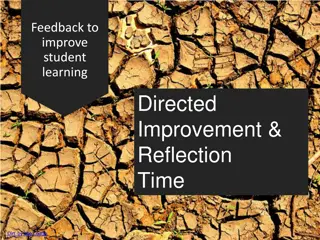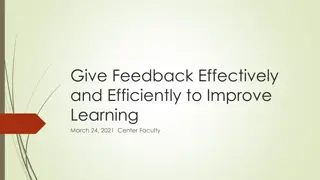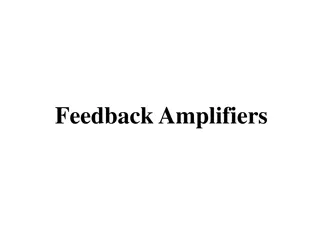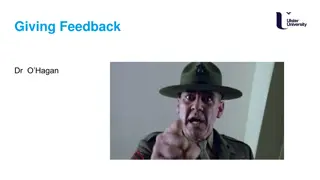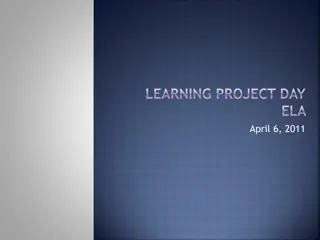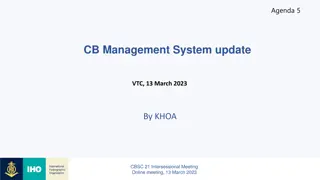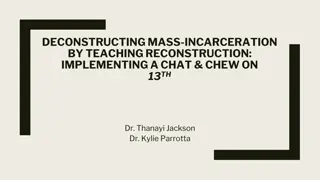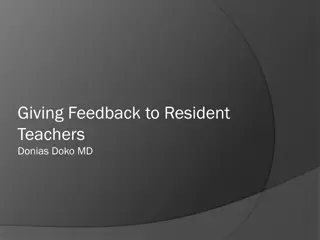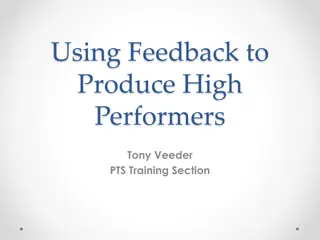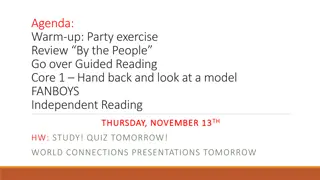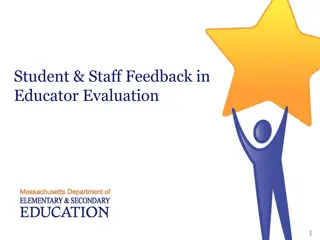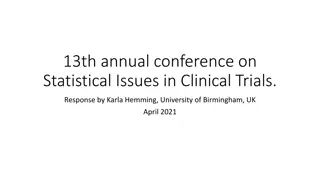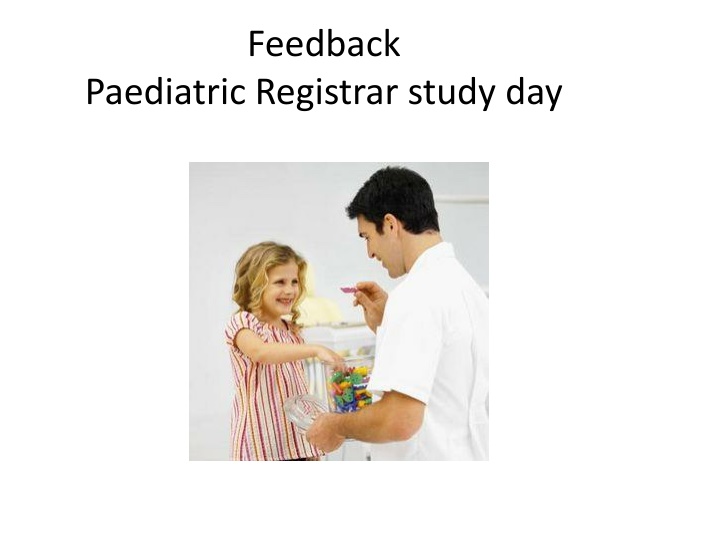
Effective Feedback in Paediatric Registrar Study Day: A Comprehensive Review
Discover the significance of feedback in paediatric registrar study days with insights from the National Student Survey 2014. Explore definitions, good practices, and models for delivering feedback, along with common challenges encountered in the feedback process. Uncover the essence of feedback as the key factor in student progression towards desired goals.
Uploaded on | 4 Views
Download Presentation

Please find below an Image/Link to download the presentation.
The content on the website is provided AS IS for your information and personal use only. It may not be sold, licensed, or shared on other websites without obtaining consent from the author. If you encounter any issues during the download, it is possible that the publisher has removed the file from their server.
You are allowed to download the files provided on this website for personal or commercial use, subject to the condition that they are used lawfully. All files are the property of their respective owners.
The content on the website is provided AS IS for your information and personal use only. It may not be sold, licensed, or shared on other websites without obtaining consent from the author.
E N D
Presentation Transcript
Feedback Paediatric Registrar study day http://www.multiplesandmore.com/wp-content/uploads/2012/10/article-new-ds-photo-getty-article-178-34-57439926_XS.jpg
National Student Survey 2014 results show record levels of satisfaction The Times Higher Education Guide August 2014 Students are most satisfied with teaching, least happy with assessment and feedback Some 86 per cent of the 321,000 final-year undergraduates who responded to this year s survey said they were satisfied overall with their course, up from 85 per cent last year.
National Student Survey 2014: UK results 2014 Questions 2013 Satisfied* Satisfied 1-4 86% 87% The teaching on my course 5-8 72% 72% Assessment and feedback 9-12 80% 81% Academic support 13-15 78% 78% Organisation and management 16-18 84% 85% Learning resources 19-21 82% 82% Personal development 22 85% 86% Overall satisfaction
Aims of this session Develop a definition of feedback by considering your own practice Discuss recognised definitions of feedback and their theoretical basis Identify good feedback practice by observation Create a structure for delivering feedback by observation and discussion Compare your structure with recognised models
https://www.youtube.com/watch?v=_ AifOZOQh5U Start at 44.00 Something to wet the appetite .
Task 1 in pairs Think about your current teaching role; when are you required to give feedback to your learners? Yourself; when have you yourself been given feedback during your own training? What is the definition of feedback? What are the common problems that you face?
Flip chart The groups problems when giving feedback ..
Definition of feedback Interaction between teacher and student Feedback addresses the gap between a student s current level of knowledge or skill and the desired goal Effective feedback only achieved when student takes action to narrow the gap Single most important determinant of learning Positively correlated with student achievement
Another definition to consider???? Information about performance or behaviour that leads to action to affirm or develop that performance or behaviour Donaghy et al Essential Handbook of GP training
What it is not.. Not about blame Not approval or disapproval It is neutral It describes what you did NOT what was accomplished
Formative assessment : becomes a tool for learning Both teacher and student require a specific skill set Dynamic collaboration in which educational goals are constantly identified and modified Students must be aware of the educational goals and be able and empowered to take the action necessary to achieve them
Feedback: brief theoretical basis Constructivist Helps student identify and build on prior knowledge Social constructivism Vygotsky students internal learning processes are enhanced by external guidance Echoes experiential learning Kolb Requires students to develop skills of self regulation Nicol & Macfarlane-Dick
Feedback facilitates people through Kolb's learning cycle feedback
https://www.youtube.com/watch?v=v Cb0jQOCobw Good and back feedback .. Lets start to think about what helps and what does not .
Task 2: Before we go on to think about good feedback . Think of feedback that you have had to a time when you had feedback that made you feel humiliated, embarrassed or was just not helpful
Task 2 1. What was it about the CONTENT of what was said that made you feel this way? 2. What was it about the PROCESS of that feedback that made you feel this way? 3. Was there anything said about YOU that did not help either? 4. What were the EFFECTS of this on you?
Flip chart Feedback that is less than helpful ..
Task 3 In groups on your tables Use flip chart Use the task headings Bullet point ideas
Think about the same scenarios Was the content valid? Was the process okay What was it about the personal stuff NOW COME UP WITH A WAY OF GIVING THAT SAME INFORMATION THAT WOULD HAVE HELPED
BILLION DOLLAR QUESTION How do you give feedback?
Going back to this definition.. Information about performance or behaviour that leads to action to affirm or develop that performance or behaviour Donaghy et al Essential Handbook of GP training
You need to think about Content and process Information Facts/evidence Performance and behaviour Describe to not judge Suggestions for improvement Leading to action To affirm or develop performance or behaviour Honest and realistic
PREPARING TO GIVE FEEDBACK What do you need ?
PREPARING TO GIVE FEEDBACK What do you need ? 1. Facts 2. Decide on what the intention/purpose of the feedback is 3. Check the receiver is in the right state to receive it 4. Check you are in right state to give it 5. Is it timely?
GIVING THE FEEDBACK Concentrate on the content first then By what process are you going to deliver it?
GIVING THE FEEDBACK Concentrate on the content first then By what process are you going to deliver it? 1. Describe 2. Be specific 3. Direct towards observed behaviour 4. Timely 5. Select 2-3 key issues 6. Offer suggestions
GIVING THE FEEDBACK Concentrate on the content first then PROCESS AVOIDING 1. 2. 3. Describe Be specific Direct towards observed behaviour Timely Select 2-3 key issues Offer suggestions Non judgemental Non focussed Mixed messages Being too diffuse Too late after the event Overload with information Prescriptions offer suggestions 4. 5. 6.
HOW DO YOU FINISH OFF? How do you close down the session With a group? With an individual?
HOW DO YOU FINISH OFF? Check recipient is okay Check you are okay Agree a plan Ask them three things they might go and write down or do next time Record what you have said Agree to follow up and review Offer support
In summary feedback must be Specific Non-judgemental Behavioural Descriptive Provided in a supportive environment Delivered near the time of the educational experience
Which models are the group aware of? Activating prior learning . For each What are the advantages? What are the disadvantages?
Flip chart Models of feedback ..for and against
Feedback: models for structure Pendleton s Rules Safe environment, focus on strengths, no-one receives only negative comments Strict rules, constructive criticism may be overlooked in time available
Feedback: models for structure ALOBA (Agenda-led outcome-based analysis) Organise feedback around the learner s agenda Ensure balanced feedback from all the group Suggest alternatives, allow rehearsal Develop a wider discussion using consultation as learning material
Feedback: models for structure SET GO What did you SEE? What ELSE? What did you THINK John? What GOAL would you like to achieve? Any OFFERS how to get there?
Gibbs reflective cycle useful for structure and reflection on the experience Useful tool for case discussions Useful for awkward discussions Use the individual stages to structure a feedback session Encourage trainees to use this in their e portfolio and reflective logs Make sure they are not too hard on themselves in the evaluation
Feedback: in summary Created a definition of feedback and compared with recognised definitions Identified good and bad feedback by observation Developed structures for feedback and reviewed published models Now it is over to you
Mind break https://www.youtube.com/watch?v=IizB365T9T o
Task 4 role rehearsal Divide into groups Each group has a scenario You have to work out how to give feedback to the learner You can do it well, you can do it badly you can do both It needs to be performed to the group THE OTHER GROUPS HAVE TO GIVE YOU FEEDBACK AND SKILLS SPOT
You are a supervisor You have to meet with each member of the group in turn You have to give them useful feedback There are issues to be addressed with each one
Group 1 You are a clinical supervisor You have a group of 5 students One of these students is not doing as well as their peers Knowledge is not as good as the rest of the group Attendance at the supervisions is patchy This student is very quiet and contributes less than their peers You arrange to meet them individually to check their progress
Group 2 You are a clinical supervisor You have a group of 5 students One of these students is not doing as well as their peers They are consistently late for supervisions They can appear disinterested Their level of knowledge is not as good as that of their peers
Group 3 You are a clinical supervisor You have a group of 5 students One of these students is not doing as well as their peers They can appear disinterested They arrive looking scruffy and unprofessional and their interaction with both children and their parents appears to be poor and they have not started to develop the same level of skills as those of their peers Their level of knowledge is not as good as that of their peers



